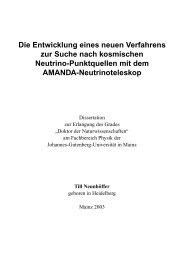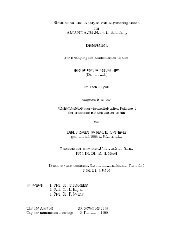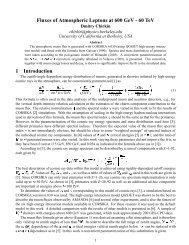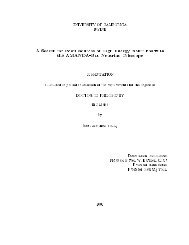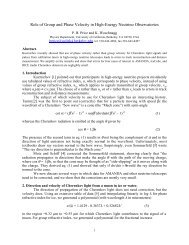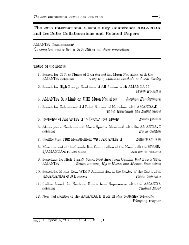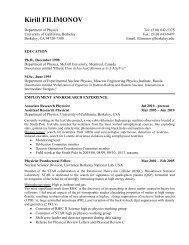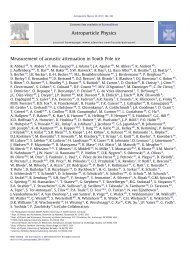Link to Fulltext
Link to Fulltext
Link to Fulltext
Create successful ePaper yourself
Turn your PDF publications into a flip-book with our unique Google optimized e-Paper software.
Thus the number of collisions <strong>to</strong> reach energy ¢<br />
¢ ¢<br />
£¢ ¤¢ ¦¡<br />
¥ ¦<br />
<br />
encounters<br />
£¦¤§ <br />
is<br />
¤¦£§<br />
¥<br />
¥<br />
£¦¤§ ¨©§§ ¨ ¤¦£§<br />
¥<br />
The probability of a particle remaining in the acceleration region for<br />
. Here is the probability of escape per interaction, given approximately by<br />
, where ¨©§§<br />
£¦¤§ ¨<br />
is the mean time between accelerating encounters, and is<br />
the mean time for escape from the accelerating region. Therefore the fraction of particles with<br />
energy greater than ¢ ¤¦¤§ <br />
¤¦¤§ ¤¦£§ ¢ <br />
¥ ¦ ¥ ¥<br />
is given by , i.e., using<br />
Eq. 7:<br />
¢ <br />
<br />
¤¦¤§<br />
¥<br />
<br />
where <br />
¡<br />
<br />
<br />
£¦¤§<br />
¨©§§ £¦¤§<br />
<br />
¤¦£§<br />
¨<br />
¤¢<br />
£¢ ¦ ¥<br />
¥<br />
¦<br />
, reproducing the expected<br />
form of the probability distribution. Replacing the number of encounters in Eq. 6 by the <strong>to</strong>tal<br />
time spent divided by ¨©§§ ¡ ¢ ¢ <br />
<br />
<br />
<br />
<br />
<br />
we get , from which we can draw two conclusions:<br />
firstly, that the maximum energy that can be reached is depending on the lifetime of<br />
the accelera<strong>to</strong>r and secondly, that particles with high energies take longer time <strong>to</strong> get accelerated<br />
than those with low energies.<br />
Charged particles can gain energy in the s<strong>to</strong>chastic way sketched above when encountering<br />
localized magnetic fields carried by blobs of interstellar plasma. Yet another possibility is encounters<br />
with a steadily moving plane shock front. In the first case, called second order mechanism,<br />
the particle can be accelerated in any direction at each encounter. The designation ’first<br />
order Fermi mechanism’ applies for the second case, where the particle gets sent out away from<br />
the shock at each encounter. First order acceleration is the more efficient, yielding a gain per<br />
encounter , whereas second order yields<br />
front the cloud, respectively.<br />
, where is the speed of the shock<br />
A value of ¡<br />
, ¦ where<br />
¢ © ¨¢<br />
<br />
¦ ¢¡ ¡ ¡<br />
¡ <br />
£ <br />
<br />
¢ <br />
<br />
© ¢ <br />
¡ ¨ § ¢©<br />
where <br />
<br />
the fac<strong>to</strong>r<br />
<br />
<br />
is a small number, is reached in the case of first order acceleration<br />
by a strong shock of monoa<strong>to</strong>mic gas, smaller than the value of 1.7 given by spectral index<br />
measurements. Note however that this value is not taking propagation in<strong>to</strong> account and is thus<br />
valid for the spectrum at the source. An improvement can be made by modelling our galaxy as<br />
a leaky box from which cosmic rays eventually escape by diffusion and using measurements of<br />
relative abundances of spallation products. A characteristic escape time can then<br />
be derived, with (see [7]) for energies less than . The energy spectrum then<br />
becomes , consistent with observations.<br />
Plausible candidates for particle acceleration up <strong>to</strong> energies of 100 TeV are supernovae. It<br />
can be shown (see [7]) that first order Fermi acceleration by the shocked gas of a supernova shell<br />
can at most yield an energy depends on the diffusion<br />
model, is the shock front velocity and ¨<br />
¡ ¡ ¢¡<br />
¥<br />
is the lifetime of the shock years. This gives<br />
a maximum energy compatible with 100 TeV but does leave open the question about how the<br />
more energetic particles are accelerated.<br />
is<br />
<br />
¢ <br />
¢<br />
¡<br />
© <br />
<br />
<br />
6<br />
(7)<br />
(8)



